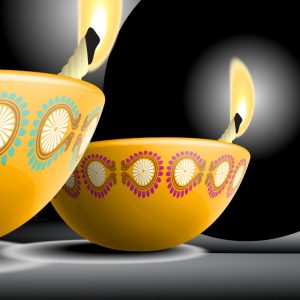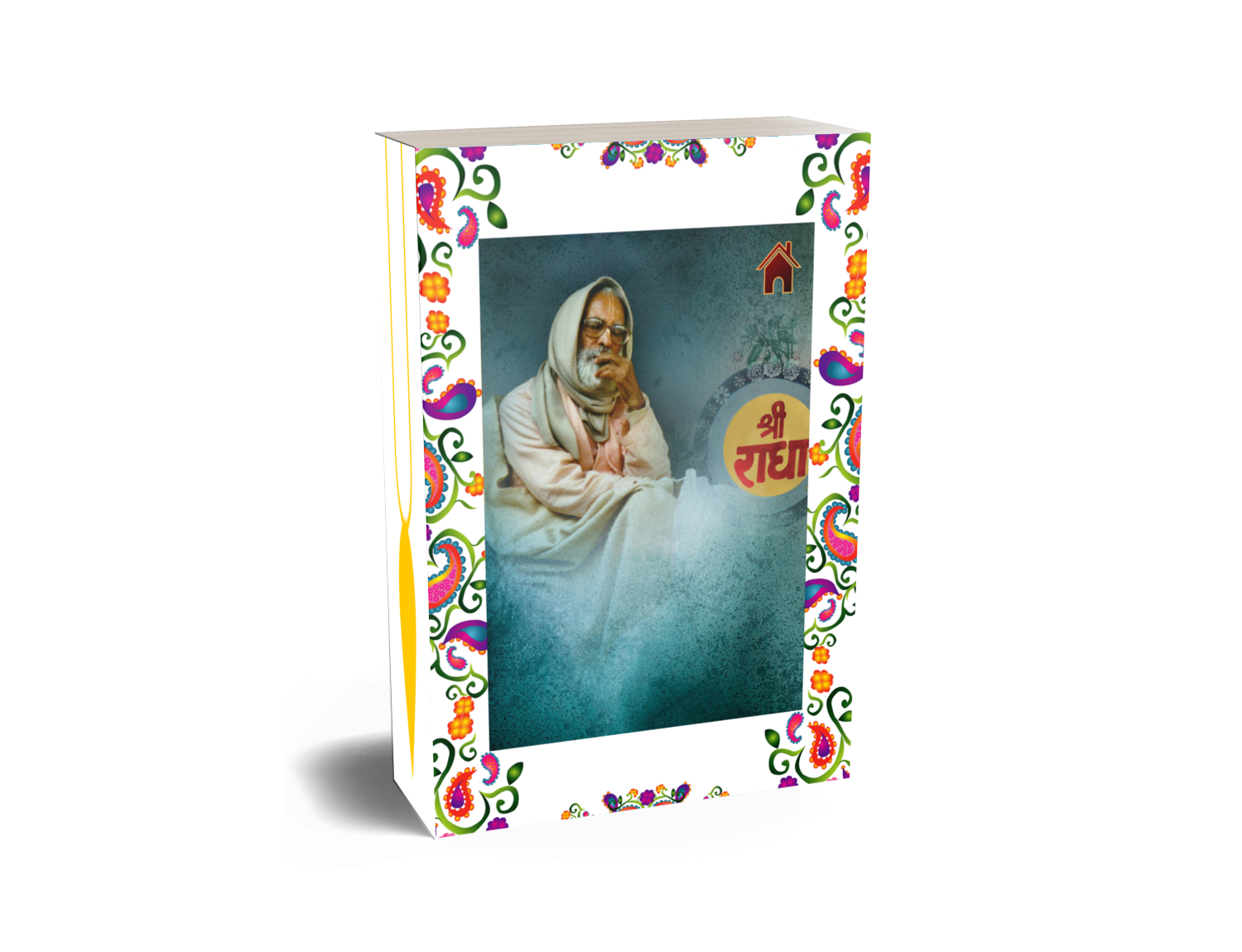

The following is an excerpt from a class by Śrīla Bhaktivedānta Nārāyaṇa Mahārāja at Śrī Rūpa-Sanātana Gauḍīya Maṭha in Vṛndāvana, India, on February 8, 1993, published in Śrī Hari-kathāmṛta, Volume Two
To understand what is vyāsa-pūjā, first we have to understand who is Vyāsa. The word 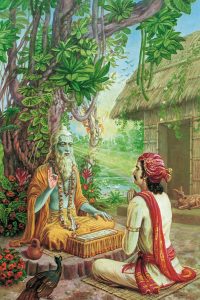 vyāsa means expansion or extension, like when from a central point we draw a circle with a compass. Vyāsa is he who from one spot extends spiritual knowledge and the glories of the Supreme Lord into the universe for the benefit of mankind. In one sense Kṛṣṇa himself is Vyāsa; in this way he diffuses his own glories. The guru is the embodiment of Kṛṣṇa’s mercy. Therefore, the spiritual master has been called sākṣād-haritvena: non-different from Hari himself. But this verse (Gurvaṣṭaka 7) has not referred to the guru as directly being Hari the viṣaya, the object of love. The guru is Hari in the sense that he is a servant of Hari. The word haritvena comes from haritva, which means possessing the guṇa, or attributes, of Hari. He in whom the attributes of Hari have appeared is called haritva. When the guru is referred to as being abhinna or non-different from Hari, it means that the guru is very, very dear to Hari. It has been told that both the guru and Śaṅkara are abhinna, or non-different, from Bhagavān and very dear to him.
vyāsa means expansion or extension, like when from a central point we draw a circle with a compass. Vyāsa is he who from one spot extends spiritual knowledge and the glories of the Supreme Lord into the universe for the benefit of mankind. In one sense Kṛṣṇa himself is Vyāsa; in this way he diffuses his own glories. The guru is the embodiment of Kṛṣṇa’s mercy. Therefore, the spiritual master has been called sākṣād-haritvena: non-different from Hari himself. But this verse (Gurvaṣṭaka 7) has not referred to the guru as directly being Hari the viṣaya, the object of love. The guru is Hari in the sense that he is a servant of Hari. The word haritvena comes from haritva, which means possessing the guṇa, or attributes, of Hari. He in whom the attributes of Hari have appeared is called haritva. When the guru is referred to as being abhinna or non-different from Hari, it means that the guru is very, very dear to Hari. It has been told that both the guru and Śaṅkara are abhinna, or non-different, from Bhagavān and very dear to him.
Within the category of guru, there is the āropita-guru and the svarūpita-guru. The guru in whom these transcendental qualities of Hari are āropa, feigned, will not be effective. The guru must factually possess these transcendental attributes, and then he is haritvena. All of Bhagavān’s personal qualities will appear in him to some degree; they are invested within him by Bhagavān himself. Like the Lord himself, there is nothing which the guru doesn’t know; he knows everything. Nothing remains unknown to him. These attributes of Hari should be visible within the guru. The guru is he who has achieved factual realisation of the purport of all the scriptures. He can dispel any doubt that a disciple may have. Also, he must have achieved direct realisation of Bhagavān. He must be fully conversant with spiritual knowledge and must have received the direct darśana of Bhagavān. He must be detached from material enjoyment; he has no desire for anything material. He keeps all of that far away. This is described in a verse from the Upaniṣads:
tad-vijñānārthaṁ sa gurum evābhigacchet
samit-pāniḥ śrotriyaṁ brahma-niṣṭham
The word śrotriyaṁ means that he possesses expertise in knowledge of the śrutis, and brahma-niṣṭham means that he is fixed in transcendence. There are many types of brahma-niṣṭham; not just one or two. There are also thousands of levels of gradation involved within it. There is brahma-niṣṭhā for the impersonal Brahman, for Paramātmā, for Nārāyaṇa, for Kṛṣṇa, and even within the category of brahma-niṣṭhā for Kṛṣṇa there are many varieties and gradations. There is brahma-niṣṭhā for Mathurā Kṛṣṇa, for Dvārakā Kṛṣṇa, for Vṛndāvana Kṛṣṇa, and within Vṛndāvana that brahma-niṣṭhā comes in the shapes of dāsya- rasa, sakhya-rasa, vātsalya-rasa and mādhurya-rasa. Within mādhurya-rasa also there are not just one or two kinds of brahma-niṣṭhā; there are many varieties of it and many gradations involved. The guru must have realisation of the highest conception of brahma, and this is why we consider Rūpa Gosvāmī to be our worshipable deity. Caitanya Mahāprabhu instructed him in detail in Prayaga and again later in Puri on how Kṛṣṇa is the ultimate conception of brahma. Mahāprabhu also described this to Raghupati Upadhyāya. He said that Kṛṣṇa is most beautiful when he is in his kiśora age (Caitanya-caritāmṛta, Madhya-līlā 19.106):
rasa, sakhya-rasa, vātsalya-rasa and mādhurya-rasa. Within mādhurya-rasa also there are not just one or two kinds of brahma-niṣṭhā; there are many varieties of it and many gradations involved. The guru must have realisation of the highest conception of brahma, and this is why we consider Rūpa Gosvāmī to be our worshipable deity. Caitanya Mahāprabhu instructed him in detail in Prayaga and again later in Puri on how Kṛṣṇa is the ultimate conception of brahma. Mahāprabhu also described this to Raghupati Upadhyāya. He said that Kṛṣṇa is most beautiful when he is in his kiśora age (Caitanya-caritāmṛta, Madhya-līlā 19.106):
śyāmam eva paraṁ rūpaṁ
purī madhu-purī varā
vayaḥ kaiśorakaṁ dhyeyam
ādya eva paro rasaḥ
“The form of Śyāmasundara is the supreme form, the city of Mathurā is the supreme abode, Kṛṣṇa’s fresh youth should always be meditated upon and the mellow of conjugal love is the supreme mellow.”
His form as Śyāma is topmost, and his form as Śyāma within Mathurā-purī is topmost and supreme. The inner meaning of “within Mathurā-purī” here means within Vraja. Within Vraja, his bhāva at Govardhana is topmost, and at Govardhana, his bhāva at Rādhā-kuṇḍa and Śyāma-kuṇḍa is topmost. Amongst all of this, his form as a kiśora is the highest. By my saying kiśora here don’t understand that there is only one type of kiśora form; there are 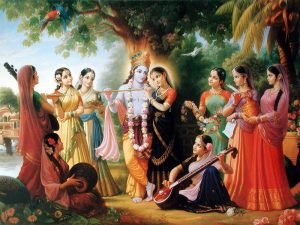 many varieties. After passing the juncture of the paugaṇḍa (from six to ten years old) and kiśora (from ten to sixteen years old) ages, Kṛṣṇa enters into the first stage of kiśora. Subsequently, he gradually reaches the madhya, or intermediate, stage, and then he reaches the vyakta, or fully revealed, stage of kiśora. After this, he reaches the age of yauvana, adolescence. The topmost age of kiśora that Caitanya Mahāprabhu was referring to is the intermediate when Kṛṣṇa is perhaps thirteen or fourteen years old. At this age Kṛṣṇa expresses his identity by feeling, “I am the nāyaka, master, of śṛṅgāra-rasa.” This is known as dhīra-lalita and so forth.
many varieties. After passing the juncture of the paugaṇḍa (from six to ten years old) and kiśora (from ten to sixteen years old) ages, Kṛṣṇa enters into the first stage of kiśora. Subsequently, he gradually reaches the madhya, or intermediate, stage, and then he reaches the vyakta, or fully revealed, stage of kiśora. After this, he reaches the age of yauvana, adolescence. The topmost age of kiśora that Caitanya Mahāprabhu was referring to is the intermediate when Kṛṣṇa is perhaps thirteen or fourteen years old. At this age Kṛṣṇa expresses his identity by feeling, “I am the nāyaka, master, of śṛṅgāra-rasa.” This is known as dhīra-lalita and so forth.
The guru is he who is fully conversant with this conception, who has factually realised it and who has similarly realised Kṛṣṇa’s pastimes that are associated with it. He must also be detached from material enjoyment. If the guru does not fit this description, then what can he possibly give the disciple? We especially honour more the conception of guru-tattva that has been given by recent mahājanas like Rūpa Gosvāmī, Sanātana Gosvāmī, Raghunātha dāsa Gosvāmī and Viśvanātha Cakravartī Ṭhākura, all of whom appeared thousands of years after the ancient sages. All the symptoms of a guru or mahā-bhāgavata Vaiṣṇava have been given in the Śrīmad-Bhāgavatam. In the scriptures twenty-six qualities have been given for a Vaiṣṇava, but some of them are based on the impersonal conception of the absolute. The personal associates of Caitanya Mahāprabhu such as the gosvāmīs have given something over and above these twenty-six qualities as the description of a mahā-bhāgavata Vaiṣṇava. The twenty-six qualities of a Vaiṣṇava are kṛpālu (merciful), akṛta-droha (humble), satya-sāra (truthful), maunī (silent), akiñcana (possessionless) and so forth. Amongst these twenty-six, the topmost is kṛṣṇaika-śaraṇa, being exclusively surrendered to Kṛṣṇa. But when Rāmānanda Rāya presented this thought to Caitanya Mahāprabhu, Mahāprabhu said, “eho bāhya—this is external.” Śaraṇāgati is the gateway to the realm of bhakti that we have not yet entered. In my opinion we are followers of those elevated mahājanas such a Rūpa Gosvāmī, Raghunātha dāsa Gosvāmī and Narottama Ṭhākura who are absorbed in kīrtana, śravaṇa and smaraṇa of the yugala-kiśora Rādhā-Kṛṣṇa. We won’t follow those who are śaraṇāgatas, merely surrendered to Kṛṣṇa. Yes, they are great personalities, mahā-bhāgavatas, gurus—that is alright. We offer praṇāma unto them time and again, we keep the dust of their feet on our heads and we never think less of them. The ancient scriptures mention twelve mahājanas: Brahmā, Nārada, Śambu, Sanat-kumāra, Kapila, Manu, Janaka, Bhīṣma, Bali Mahārāja, Vaiyāsaki, Prahlāda and Yamarāja. But rather than following them, we follow devotees like Rūpa and Raghunātha because in these others we don’t detect the symptom of exclusive niṣṭhā for Rādhā-Kṛṣṇa. The devotional sentiments found within the paramparā emanating from Mahāprabhu don’t exist within them. 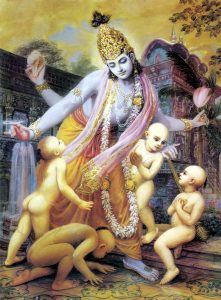 One can search for these sentiments within them, but will simply become exhausted and never find them. They are all mahā-bhāgavatas and are always fixed in meditation upon the particular four-armed form of Nārāyaṇa whom they worship. But we don’t read anywhere that any of them, not even Nārada, are more devotionally inclined toward Rādhā than they are towards Kṛṣṇa. Nārada is a mahājana, a disciple of Brahmā, the original guru in our paramparā, and he has also been to Vraja, but within him we don’t see the bhāva that is possessed by the gosvāmīs.
One can search for these sentiments within them, but will simply become exhausted and never find them. They are all mahā-bhāgavatas and are always fixed in meditation upon the particular four-armed form of Nārāyaṇa whom they worship. But we don’t read anywhere that any of them, not even Nārada, are more devotionally inclined toward Rādhā than they are towards Kṛṣṇa. Nārada is a mahājana, a disciple of Brahmā, the original guru in our paramparā, and he has also been to Vraja, but within him we don’t see the bhāva that is possessed by the gosvāmīs.
The guru is he who possesses this bhāva and who gives primary importance to the performance of kīrtana. Smaraṇa, or remembrance, of Kṛṣṇa’s nitya-līlā is generally considered the most important limb of bhakti because it is the function of the mind. By the function of the mind smaraṇa is performed, but this is Kali-yuga. In this age, the performance of kīrtana is emphasised. Only by the medium of kīrtana is remembrance accomplished. To see how, take this verse written by Raghunātha dāsa Gosvāmī as an example:
bhajāmi rādhāṁ aravinda-netrāṁ
smārami rādhāṁ madhura-smitāsyām
vadāmi rādhāṁ karuṇā-bharādrāṁ
tato mamānyāsti gatir na kāpi
“I worship Rādhā who has lotus eyes, I remember Rādhā who has a sweet smile and I speak of Rādhā who is melted with compassion. In this way, I have no other goal.”
Meditate on this verse and bring this description of Rādhikā into your heart. Also meditate on Kṛṣṇa giving the highest importance to Rādhikā, the mood of their Sevā-kuñja pastimes. By the medium of performing kīrtana in line with the moods expressed in verses like this one which is written by the gosvāmīs, smaraṇa will automatically take place. Śrīla Bhaktisiddhānta Prabhupāda writes:
kīrtana prabhāva, smaraṇa haibe,
se kāle bhajana-nirjana sambhava
“When by the influence of kīrtana one genuinely enters into smaraṇa, then he will be capable of performing bhajana in a solitary place.”
The guru is he who is fully knowledgable in these matters. The sādhaka should find a guru who is situated within the line in which he is aspiring. If the guru and sādhaka don’t share the same mood, their relationship will not bear fruit; in other words, the disciple will not enter into the conception given by Caitanya Mahāprabhu. The guru should be fully realised in regard to that which Caitanya Mahāprabhu descended into this world to give, and then he is capable of giving that same thing to the disciple. Especially, it has been said that the guru is not of an ordinary standard. At the very least the guru should be a madhyama or intermediate uttama-adhikārī, and then the mercy which he bestows upon the disciple will be effective. If the guru is not up to this standard, then in reality he can only give some general help to the disciple. In such a situation the disciple will not realise the highest things within his heart. It has been said that the guru should be of one of these classes: a kaniṣṭha or preliminary uttama-adhikārī, a madhyama or intermediate uttama-adhikārī or an uttama or topmost uttama-adhikārī. Such a topmost devotee has the power to make all spiritual perfection arise within a person’s heart simply by placing his hand on their head and bestowing his mercy.
The kaniṣṭha uttama-adhikārī is known as mūrcchita-kaṣāya, which means that he still has material desires, but they are lying in a dormant condition and are unable to do any harm. An example of this is Nārada in his previous birth as the son of a maidservant. He was engaged in bhakti-sādhana and then one day Bhagavān granted him a brief darśana. When Bhagavān departed, Nārada began lamenting and then in a voice from the sky the Lord said to him, “As long as you remain in this material body which has been produced by karma and as long as you harbour material desires, you cannot obtain my constant association. Now perform sādhana-bhajana by traversing the earth and singing my glories. Preach the glories of my name everywhere.” At that time Nārada was in mūrcchita-kaṣāya. All of one’s anarthas may have disappeared, but as long as the body produced by previous karma remains, there is always the possibility that material desires can come. When one receives Bhagavān’s mercy and performs bhajana more and more, when one’s material body no longer remains, when one puts his feet on the head of death and receives the body of a 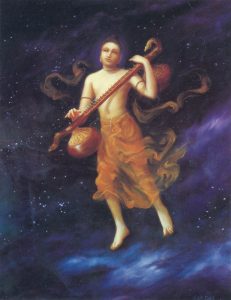 liberated soul, when not even a scent of anarthas or material desires remain, then one has become an uttama or topmost uttama-adhikārī. This is the stage known as bhagavat-pārṣada-deha-prāpta, having obtained a spiritual body suitable for rendering service in the spiritual world. Such devotees can give mercy, and on the order of Bhagavān they travel throughout the material world doing just that. Such a devotee has the power to say to someone, “May you have bhakti,” and at once bhakti will arise within him. The devotee in mūrcchita-kaṣāya with great endeavour tells others hari-kathā and is also capable of giving mercy. He has this power because all his anarthas have vanished and he is completely immersed in the glorification of the Lord.
liberated soul, when not even a scent of anarthas or material desires remain, then one has become an uttama or topmost uttama-adhikārī. This is the stage known as bhagavat-pārṣada-deha-prāpta, having obtained a spiritual body suitable for rendering service in the spiritual world. Such devotees can give mercy, and on the order of Bhagavān they travel throughout the material world doing just that. Such a devotee has the power to say to someone, “May you have bhakti,” and at once bhakti will arise within him. The devotee in mūrcchita-kaṣāya with great endeavour tells others hari-kathā and is also capable of giving mercy. He has this power because all his anarthas have vanished and he is completely immersed in the glorification of the Lord.
The intermediate uttama-adhikārī devotee is known as nirdhūta-kaṣāya. The word nirdhūta means that not even any dormant desires remain within him; they have all been cleansed away. In the case of Vyāsa, by the mercy of Nārada he was engaged in glorifying Kṛṣṇa more and more. Then everything was washed away from his heart and no anartha or anything remained there. Those who have similarly been cleansed of all material impurities are called nirdhūta-kaṣāya. An example of this class of devotees is Śukadeva Gosvāmī. Nārada, Vyāsā and many other great devotees were present at the assembly where Parīkṣit 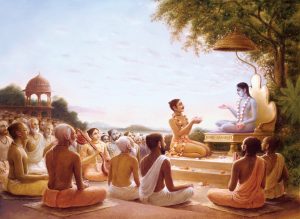 Mahārāja was to hear the Bhāgavatam, yet it was Śukadeva whom they wanted to hear it from—why? Because he was nirdhūta-kaṣāya, having no trace of material desire. Once he passed by several women as they were bathing. Although he saw them as they were naked, it had no meaning to him and he was not affected. Vyāsa sent him to Mithila for instruction, and like an avadhūta he arrived there without wearing any clothes. The king had previously given the order to not let him enter. At the first gate the guards stopped him. They said, “Wait here; we are going inside to obtain the order for you to enter,” but they didn’t return for two or three days. Not knowing what was happening, Śukadeva continued waiting there all that time. Then the guards returned and said, “Yes, you can enter now.” So they led him in, but only to another gate. Situated there were many beautiful sixteen-year-old girls who led him around the hundreds of enchanting gardens on the palace grounds. All the while they were trying to allure him with provocative gestures, yet it meant nothing whatsoever to him. Next he was led inside where he was instructed by Janaka. Janaka was also not an ordinary personality. So Śukadeva was nirdhūta-kaṣāya, and by the mercy of Vyāsa the rasa described in the Bhāgavatam arose within his heart. Then he was able to speak the Bhāgavatam before such an exalted assembly. Such great personalities are capable of simply glancing at someone and bestowing upon him all spiritual perfections.
Mahārāja was to hear the Bhāgavatam, yet it was Śukadeva whom they wanted to hear it from—why? Because he was nirdhūta-kaṣāya, having no trace of material desire. Once he passed by several women as they were bathing. Although he saw them as they were naked, it had no meaning to him and he was not affected. Vyāsa sent him to Mithila for instruction, and like an avadhūta he arrived there without wearing any clothes. The king had previously given the order to not let him enter. At the first gate the guards stopped him. They said, “Wait here; we are going inside to obtain the order for you to enter,” but they didn’t return for two or three days. Not knowing what was happening, Śukadeva continued waiting there all that time. Then the guards returned and said, “Yes, you can enter now.” So they led him in, but only to another gate. Situated there were many beautiful sixteen-year-old girls who led him around the hundreds of enchanting gardens on the palace grounds. All the while they were trying to allure him with provocative gestures, yet it meant nothing whatsoever to him. Next he was led inside where he was instructed by Janaka. Janaka was also not an ordinary personality. So Śukadeva was nirdhūta-kaṣāya, and by the mercy of Vyāsa the rasa described in the Bhāgavatam arose within his heart. Then he was able to speak the Bhāgavatam before such an exalted assembly. Such great personalities are capable of simply glancing at someone and bestowing upon him all spiritual perfections.
These three classes of devotees cannot perform the function of guru; they must come down a little to a lower stage to do that. Such devotees are unable to discriminate between 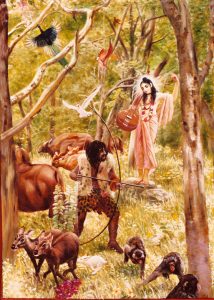 conditioned souls and liberated souls. Sometimes a little semblance of discrimination is possible. What are the activities of such a guru? He says, “Perform hari-bhajana, chant Hare Kṛṣṇa; that’s all. May all perfections arise within you.” Once Nārada came across a hunter shooting birds and Nārada gave him a little mercy. Nārada had him sit down and chant, and after some time the man broke his bow, threw it away and became immersed in bhajana.
conditioned souls and liberated souls. Sometimes a little semblance of discrimination is possible. What are the activities of such a guru? He says, “Perform hari-bhajana, chant Hare Kṛṣṇa; that’s all. May all perfections arise within you.” Once Nārada came across a hunter shooting birds and Nārada gave him a little mercy. Nārada had him sit down and chant, and after some time the man broke his bow, threw it away and became immersed in bhajana.
These are the three types of most elevated guru. If we meet such a guru, in an instant we can cross over the ocean of material existence. Such gurus are very, very rare but it is possible to find them. If our saṁskāra, acquired nature, is sufficiently developed, Bhagavān will arrange for us to meet such a guru. Another point here—suppose the association of not one of these three types of guru are available to us. So will we just not perform bhagavat-bhajana then? Especially at the time of searching for a spiritual master, a sādhaka is not very knowledgeable. So from whom will he hear? He thinks, “I am considering now whom to select as my guru.” At that time he is completely innocent, but he has little faith. If he has some saṁskāra from his previous life, he will understand something. Otherwise, he won’t be able to understand who is a qualified guru and who isn’t. At that time, Bhagavān acts to establish a relationship with a guru for him. So if the association of one of these three types of devotee is not available, then one should associate with a madhyama-adhikārī guru who is a little inferior to them but who is expert in knowledge of the scriptures, detached from material enjoyment, possesses some direct realisation of Bhagavān and capable of dispelling a disciple’s doubts. By the influence of his good conduct, by giving instruction from the scriptures and by bestowing mercy, such a guru can make a disciple progress in spiritual life and eventually lead him to Bhagavān. Such devotees are also fit to be revered as gurus.
Besides the dīkṣā-guru, there are two other varieties of this kind of guru: the śravaṇa-guru and the śikṣā-guru. The śravaṇa-guru recites the scriptures to one and leads him to a pure spiritual master. There is also the vartma-pradarśaka guru who leads one to a qualified spiritual master. The śravaṇa-guru and the śikṣā-guru are generally one and the same person. Sometimes the dīkṣā-guru, śravaṇa-guru and śikṣā-guru are the same person. Suppose a disciple did not have a substantial amount of association with his dīksā-guru or his dīkṣā-guru has passed away. At that time he will accept a śikṣā-guru who is of the same mood and qualification as his dīkṣā-guru. One should never disrespect his dīkṣā-guru, śikṣā-guru or vartma-pradarśaka-guru because they are of the same mood and intention. If a devotee is not of the same mood as one’s dīkṣā-guru, then he cannot act as the śikṣā-guru. One should never disrespect his śikṣā-guru or see him as different from the dīkṣa-guru. The external manifestation of guru is known as the mahanta-guru, and Kṛṣṇa gives us mercy internally as the caittya-guru. The dīkṣā-guru is Kṛṣṇa’s rūpa and the śikṣa-guru is Kṛṣṇa’s svarūpa: śikṣā-guruke ta ’jani kṛṣṇera-svarūpa (Śrī Caitanya-caritāmṛta, Ādi- līlā 1.47).
In my case, my spiritual master is my dīkṣā-guru, Śrīla Bhakti Prajñāna Keśava Gosvāmī 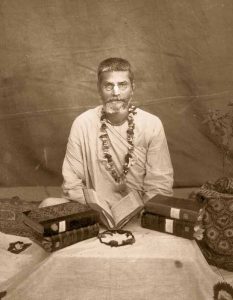 Mahārāja. Then, for instance, there is Pūjyapāda Śrīla Śrīdhara Mahārāja who has many disciples. For them he is acting as dīksā-guru but he also gives śikṣā to me. So Śrīdhara Mahārāja has become my śikṣā-guru, and my own guru is my dīkṣā-guru. If there are any disciples of Śrīdhara Mahārāja who accept instruction from my guru, then for them my guru has become their śikṣā-guru. Who will I consider superior, my own guru or Śrīla Śrīdhara Mahārāja? It is likely that my love and affection will be more for my own guru. My niṣṭhā will be more for my own guru—this is correct, and I will serve him with all my heart. But if I say that Śrīdhara Mahārāja is less than him and that Śrīdhara Mahārāja is incapable of serving Bhagavān, it will be a great offence. All Vaiṣṇavas who possess the necessary qualification are guru, and we should give them appropriate respect.
Mahārāja. Then, for instance, there is Pūjyapāda Śrīla Śrīdhara Mahārāja who has many disciples. For them he is acting as dīksā-guru but he also gives śikṣā to me. So Śrīdhara Mahārāja has become my śikṣā-guru, and my own guru is my dīkṣā-guru. If there are any disciples of Śrīdhara Mahārāja who accept instruction from my guru, then for them my guru has become their śikṣā-guru. Who will I consider superior, my own guru or Śrīla Śrīdhara Mahārāja? It is likely that my love and affection will be more for my own guru. My niṣṭhā will be more for my own guru—this is correct, and I will serve him with all my heart. But if I say that Śrīdhara Mahārāja is less than him and that Śrīdhara Mahārāja is incapable of serving Bhagavān, it will be a great offence. All Vaiṣṇavas who possess the necessary qualification are guru, and we should give them appropriate respect.
Suppose with this mood towards my own guru I am engaged in serving him and suddenly Nārada, Vyāsa or Śukadeva were to come here—what should my mood be towards them? I will have to consider at that time whether to possibly disrespect my own guru or them. First I should show respect to my own guru by taking his permission, and then show them respect which is equal to that which I show my own guru. All of these points are explained in the scriptures, and in accordance with them we will go forward in our spiritual lives.
In ancient times, just before the end of Dvārapa-yuga, the scriptures had all disappeared. Brahmā and the other demigods approached Bhagavān and prayed to him, “O Lord, the śāstras are disappearing, people are not following the vow of brahmacarya as before, and because peoples’ memories are not as they were before, they no longer retain what they hear. How will they acquire the knowledge to guide their lives? Please be merciful and ensure that all this knowledge does not disappear.” At that time Bhagavān, seeing that there was no suitable jīva he could empower for the purpose, came himself as Vyāsadeva. Sometimes Bhagavān empowers a jīva for a specific purpose. When he desires to illuminate knowledge, he empowers a jīva to diffuse that knowledge. Ṛṣabhadeva and Kapiladeva are examples of such jñāna-śaktyāveśa-avatāras. Nārada is a bhakti-avatāra, and through him Bhagavān preaches bhakti. Paraśarāma and Pṛthu Mahārāja are also examples of aveśa-avatāras. When Bhagavān finds no suitable jīva to empower, Bhagavān as Garbhodaśāyī Viṣṇu descends and performs the function of Vyāsa. Specifically he comes to divide the Vedas, manifest the Purāṇas and finally compose the Śrīmad-Bhāgavatam. For Vyāsa to compose the śāstras, a scribe was necessary. So Vyāsa 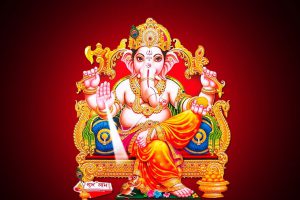 said to Brahmā, “I require a scribe.”
said to Brahmā, “I require a scribe.”
Brahmā called Gaṇeśa and said, “You must do a little writing for Vyāsadeva.”
Gaṇeśa replied, “I am so intelligent that very quickly I will become bored with this.” He hadn’t been informed that Vyāsadeva was actually Nārāyaṇa himself, so he was a little indifferent. Then Gaṇeśa said, “I will do it, but if in the midst of it my pen ever stops writing, I will stop right there and not go any further. I must be constantly engaged.”
Vyāsa replied, “I agree to that, but if you write without understanding, you will not benefit. You must understand everything that you are writing. First understand everything that I say, then write it.”
Gaṇeśa said, “I am like Sarasvatī, a storehouse of endless knowledge. What is there that I cannot possibly understand?”
Then, to keep Gaṇeśa’s constant attention, Vyāsa composed very difficult verses in the Purāṇas and especially in the Bhāgavatam that are called vyāsa-kūṭa. Two of these verses are the first verse of the Bhāgavatam, janmādy asya yato ’nvayād and vadanti tat tattva-vidas (Śrīmad-Bhāg. 1.2.11). The meaning of the entire Bhāgavatam comes within the explanation of these two verses. Ask any scholar who is not following the line of Caitanya Mahāprabhu, “This verse, vadanti tat tattva vidas, explains how Kṛṣṇa is advaya-jñāna svarūpa—what is the meaning?” They will be unable to reply. Even great scholars are baffled by this śloka. Also, at the time when Vyāsa composed this verse, no one had ever heard of such a thing. The nature of these vyāsa-kūṭa verses is that they have an ordinary, external meaning and also a much deeper, inner meaning.
After dividing the Vedas, Vyāsa composed all the scriptures and Purāṇas. There are fifty-four Purāṇas all together—Purāṇas, Upapurāṇas and Sakha-purāṇas. After composing all of this, he was still not satisfied. He had not written something that women and śūdras could understand, so he wrote the Mahābhārata. It is a symptom of his sharp intelligence that he wrote the Mahābhārata. What is the meaning of the word śūdra? It means one who feels śoka, sorrow and so forth, for the material body. Śūdras are busy in fighting and quarrelling, so for them he composed Mahābhārata. Therein he described Kṛṣṇa’s life story and the war between the Pāṇḍavas and Kauravas. Why were they fighting? For control of the kingdom. It seems that the Pāṇḍavas were also fighting just for the sake of a kingdom, so therefore they were the same as the Kauravas. But did the Pāṇḍavas have any necessity for a kingdom? Definitely not. Kṛṣṇa arranged all of this to relieve the Earth of its burden. Kṛṣṇa’s friend Arjuna said, “What necessity do I have for a kingdom soaked with the blood of my relatives? I will live by begging and perform bhajana.” But Kṛṣṇa forbade him and told him to fight instead. Then Arjuna said to Kṛṣṇa, “I am surrendered to you and will do as you instruct me.” Then so much fighting ensued. Bhīma broke Duryodhana’s thigh and with the blood-washed 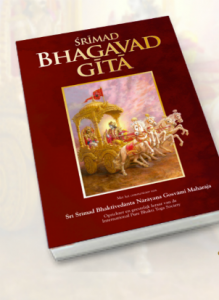 Draupadī’s hair. Śūdras who possess tamasic-bhāva find all of this tasteful. This book is a medium for teaching people gradually to live peacefully. Then bhagavat-tattva is delineated and the reader can progress spiritually. Situated within that same Mahābhārata is the Bhagavad-gītā. The Gītā gives instruction on bhagavat-tattva, māyā-tattva and jīva-tattva and nothing more. If someone wants to know more than this, then they have to read the Bhāgavatam. For ordinary people, the instructions of the Gītā are appropriate to learn and follow first. When after maturing and advancing, they can study the PhD course of the Bhāgavatam. There bhagavat-tattva is described with rasa; this is our worshipable object.
Draupadī’s hair. Śūdras who possess tamasic-bhāva find all of this tasteful. This book is a medium for teaching people gradually to live peacefully. Then bhagavat-tattva is delineated and the reader can progress spiritually. Situated within that same Mahābhārata is the Bhagavad-gītā. The Gītā gives instruction on bhagavat-tattva, māyā-tattva and jīva-tattva and nothing more. If someone wants to know more than this, then they have to read the Bhāgavatam. For ordinary people, the instructions of the Gītā are appropriate to learn and follow first. When after maturing and advancing, they can study the PhD course of the Bhāgavatam. There bhagavat-tattva is described with rasa; this is our worshipable object.
When after having composed all of this, Vyāsa was still not peaceful within himself, Nārada met with him and said, “You appear to be dissatisfied—why? I see that your mind is disturbed and you are feeling sorrowful.”
Vyāsa replied, “I don’t understand why myself.” This is because the patient cannot determine the cause of his own illness. Only a doctor can diagnose it for him. Vyāsa said, “Please tell me, why am I feeling this way?”
Nārada said, “In the scriptures you described karma, dharma and everything, but you didn’t factually describe the highest feature of Bhagavān. You described all the demigods and incarnations, but you never mentioned that Kṛṣṇa alone is Svayam-Bhagavān. You didn’t describe how Svayam-Bhagavān performs such variegated pastimes in Vraja. You didn’t describe how his mother grabs the ear of that Parabrahma, while in their meditation the brahmavādīs cannot catch even a fleeting glimpse of the beams of effulgence emanating from the nails of his lotus feet—what to speak of seeing the rest of him! So please describe all of this, and especially describe how the Lord becomes subjugated by his devotees. You described how devotees worship Bhagavān, but you didn’t describe how Kṛṣṇa, who is Svayam-Bhagavān and the topmost limit of viṣṇu-tattva, himself performs arādhana, worship, of his devotees in a similar way. When he simply hears the syllable rā, his anurāga, natural love, increases at once, and upon hearing the syllable dha, he is completely overwhelmed. Her name is Rādhā. You didn’t describe her. You didn’t describe how Kṛṣṇa descended directly from Goloka-Vṛndāvana with his eternal devotees to perform these pastimes for the benefit of the souls of this world. Especially you have not described his beautiful rāsa-līlā and his prema. You didn’t describe how his prema has two aspects, vipralambha and sambhoga. Without vipralambha, the pastimes in sambhoga, meeting, would not be strengthened. Please describe all of this.”
Vyāsa asked, “But how will I describe all of this?”
Nārada replied, “First purify your heart by practising bhakti-yoga. It will purify your heart in such a way that jñāna, karma, yoga, tapasyā and vratas cannot.”
na sādhayati māṁ yogo
na sāṅkhyaṁ dharma uddhava
na svādhyāyas tapas tyāgo
yathā bhaktir mamorjitā
“My dear Uddhava, the unalloyed devotional service rendered to me by my devotees brings me under their control. I cannot be thus controlled by those who engage in mystic yoga, Sāṅkhya philosophy, pious work, Vedic study, austerity or renunciation.” (Śrīmad-Bhāgavatam 11.14.20)
Understand the meaning of tapasyā, austerity, to be following days of observance such as Ekādaśī. How should we follow ekādaśī-vrata? In his Jaiva-dharma, Bhaktivinoda Ṭhākura has explained how we should follow hari-vāsara, days of observance. The day before we should maintain brahmacarya and take prasāda only once. Brahmacarya means in the ordinary sense “maintaining celibacy,” and beyond that it means “immersing one’s mind in brahma or transcendence through the medium of speaking, hearing or reading hari-kathā.” On the day of Ekādaśī itself, fast from everything including water, refrain from resting during the day and remain awake all night. What should one do during these twenty-four hours in which he does not sleep? Nothing except be immersed in meditating on Bhagavān, in hearing narrations of his pastimes and in performing hari-kīrtana. The following morning, after bathing one should worship the deity, offer respect to all the Vaiṣṇavas and then break his fast. On that day also one should take prasāda only once. This is real observance of Ekādaśī, but what can we do? If we don’t eat for even one day, what would happen? On Ekādaśī we take two full meals of prasāda and on top of that numerous snacks throughout the day. We also rest for two or three hours in the afternoon!
Nārada advised Vyāsa to practise bhakti-yoga. Bhakti-yoga means first there is śraddhā, then one’s anarthas begin to disappear, then one takes shelter of a guru and performs bhajana, then serves the guru with viśrambha-bhāva, intimacy, hears hari-kathā from him, learns from him how to practise sādhana-bhajana and then engages in the sixty-four types of bhakti. It is not that one just purchases a copy of the Govinda-līlāmṛta and starts reading it at home. In that case one might study it merely to learn how to better associate with women, and in this way he descends down to the hellish planets. This is not how to practise bhakti. Everything depends on the guru. Seeing to what degree we are qualified, he will gradually lead us into bhakti. Otherwise, being full of anarthas and not fully understanding the ABCs of spiritual life, we will imagine ourselves to be gopīs and adopt the path of smaraṇa. This is opposed to the injunctions of the scriptures. The guru will only bestow these elevated topics upon the disciple when he sees that the disciple has become fully qualified for them, when he detects greed for them within a disciple and after he has thoroughly deliberated on it. Nārada obtained his eternal form, but we must consider this—when did he obtain it? Only after performing sufficient sādhana-bhajana. So performing sādhana is not as easy as we understand it to be.
We should consider all of this and follow the example of Nārada. Then it will happen for us. All of these things should be pursued under the guidance of the spiritual master. These days gurus try to give the highest perfection to disciples who are still full of anarthas and who possess no greed or anything. But what did Vyāsadeva do? Within him was the bhakti of Vaikuṇṭha. By the mercy of Nārada the pastimes of Kṛṣṇa appeared before him within his heart. Since Nārada is an uttama-bhagavata devotee, he bestowed mercy on Vyāsa in the ways that I described before. By merely glancing at Vyāsa, by his instructions and by giving his merciful touch, he invested inspiration within him. These are the three types of mercy. By doing this, he gave Vyāsa everything internally and made so many things appear within Vyāsa. Then, by the practice of bhakti-yoga, Vyāsa could easily compose the Bhāgavatam as he sat in his āśrama on the banks of the Sarasvatī River. Then the śuddha-sattva  potency appeared in his heart and by the independent will of that śakti, within himself he began witnessing the flow of Bhagavān’s pastimes as if they were on a cinema reel. One by one these pastimes appeared to him. He saw Kṛṣṇa’s pastimes in Dvārakā and even pastimes from the aprakaṭa-līlā, which were not manifest in this world. He realised all of this on the basis of the brief catuḥ-ślokī found in the Bhāgavatam, and from that he manifested the entire Bhāgavatam. Then, within the Bhāgavatam he narrated those pastimes which he had not described in other Purāṇas or scriptures.
potency appeared in his heart and by the independent will of that śakti, within himself he began witnessing the flow of Bhagavān’s pastimes as if they were on a cinema reel. One by one these pastimes appeared to him. He saw Kṛṣṇa’s pastimes in Dvārakā and even pastimes from the aprakaṭa-līlā, which were not manifest in this world. He realised all of this on the basis of the brief catuḥ-ślokī found in the Bhāgavatam, and from that he manifested the entire Bhāgavatam. Then, within the Bhāgavatam he narrated those pastimes which he had not described in other Purāṇas or scriptures.
bhakti-yogena manasi
samyak praṇihite ’male
apaśyat puruṣaṁ pūrṇaṁ
māyāṁ ca tad-apāśrayām
“By the power of bhakti-yoga, Śrīla Vyāsadeva, being firmly concentrated in meditation with a purified mind, saw Śrī Kṛṣṇa fully endowed with spiritual effulgence, with his plenary portions and with his internal potency of svarūpa-śakti. His external potency māyā, being of an inferior nature, was seen in the background under his control.” (Śrīmad-Bhāg. 1.7.4)
He saw the pūrṇa-puruṣa, Complete Person. Pūrṇa-puruṣa means Kṛṣṇa when he is accompanied by the embodiment of his śakti, Śrīmatī Rādhikā; without seeing them together, one cannot say that he has seen the pūrṇa-puruṣa. And what is the nature of Śrīmatī Rādhikā? She has many sakhīs, and each of them embodies one of her bhāvas. Vyāsa also received darśana of the many ways in which they serve the Divine Couple. Vyāsa saw how māyā was in the background and how the jīvas who had forgotten Kṛṣṇa were trapped in the material energy. He also saw how by taking shelter of holy men they were gradually rectified and moved towards Bhagavān.
yasyāṁ vai śrūyamāṇāyāṁ
kṛṣṇe parama-pūruṣe
bhaktir utpadyate puṁsaḥ
śoka-moha-bhayāpahā
“Simply by giving aural reception to this Vedic literature, the desire to perform bhakti for Śrī Kṛṣṇa, the Supreme Person, sprouts up at once to extinguish the fire of lamentation, illusion and fearfulness.” (Śrīmad-Bhāg. 1.1.7)
This is the kind of spiritual principle he composed in the Śrīmad-Bhāgavatam. It is the meaning of the Brahma-sūtra, the objective of the Mahābhārata, the purport of the gāyatrī-mantra and the essence of the Vedas, as confirmed in this verse (Garuḍa Purāṇa, and Hari-bhakti-vilāsa 10.283):
artho ’yaṁ brahma-sūtrāṇāṁ
bhāratārtha-vinirṇayaḥ
gāyatrī-bhāṣya-rūpo ’sau
vedārtha-paribṛṁhitaḥ
Of all types of authorities, it is the spotless evidence. By taking shelter of only this one book we can attain kṛṣṇa-prema. After composing the Bhāgavatam, his sorrow was mitigated and his innermost desire was fulfilled. Then he somehow enticed Śukadeva Gosvāmī into his trap and taught it to him. Later Śukadeva spoke it before the assembly of Parīkṣit Mahārāja.
Vyāsa is known as Kṛṣṇa-dvaipāyana Vyāsa. His name is Dvaipāyana because he appeared on an island in Mathurā. This island was known as Kṛṣṇagaṅgā and was situated where the Yamunā and Sarasvatī rivers converge. It was covered in jungle. Parāśara Ṛṣi’s āśrama was on that island and he sometimes had to cross the Yamunā to come to Mathurā. On one such occasion he wanted to cross the river back over to his āśrama but night had fallen. Parāśara could have crossed the river by his mystic power, but there was a special reason why he didn’t. There was only one boatman present there to take him across. This boatman was actually a young girl named Matsyagandha, who was the daughter of an Apsarā. She had entered the womb of this Apsarā who had been cursed by Brahmā to assume the form of a fish. She was later recovered from the belly of that fish by a boatman who adopted her. Her name was Matsyagandha because her bodily odour was like that of fish. She was a young virgin girl, and she agreed to take Parāśara across the river. When they reached the island, the sage looked at her. As he looked at her, she became embarrassed, but he said, “Don’t fear. You will give birth to a son but still remain a virgin. In the future you will marry a king.” Simultaneously a son, tall with a dark complexion, was born to her. Because he was born on a dvīpa, island, his name became Dvaipāyana. Vyāsa said to his mother, “Whenever you summon me, I will come at once.” Then he left there to perform austerities.
Some say that he composed the Bhāgavatam in the Himālayas at Badarikāśrama on the banks of the Gaṅgā. But it doesn’t seem that way. By the mercy of Nārada, he again came 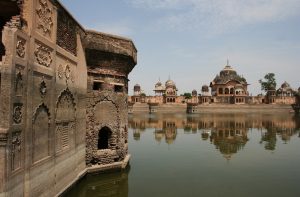 to that same place in Vṛndāvana where he took birth and stayed for a long period of time. He travelled all around the dhāma, and after obtaining the dhāma’s mercy, he could write about Kṛṣṇa’s pastimes. It is possible that after this he went to Badarikāśrama. But it was only in the rasamayī-bhumi, or land saturated with rasa, Vṛndāvana, where those feelings could have entered his heart and he could have expressed them in writing.
to that same place in Vṛndāvana where he took birth and stayed for a long period of time. He travelled all around the dhāma, and after obtaining the dhāma’s mercy, he could write about Kṛṣṇa’s pastimes. It is possible that after this he went to Badarikāśrama. But it was only in the rasamayī-bhumi, or land saturated with rasa, Vṛndāvana, where those feelings could have entered his heart and he could have expressed them in writing.
In this way, he who expanded or diffused descriptions of the Lord’s pastimes in this world is known as Vedavyāsa. He who sitting on a throne narrates those pastimes is also called vyāsa, or the guru. On the anniversary of the day of his own appearance, my spiritual master, Śrīla Bhakti Prajñāna Keśava Gosvāmī Mahārāja, would worship each of these vyāsas or gurus in the disciplic succession. Kṛṣṇa is the first guru, then Brahmā, then Nārada, Vyāsa, Śuka and then the sampradāya coming from Madhva. In accordance with all the appropriate rules and regulations, he worshipped each one from Svarūpa Dāmodara up 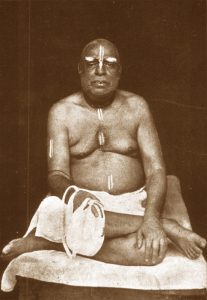 to our present-day gurus. From Puri, Bhaktivinoda Ṭhākura brought the paddhati, or system of worship, for the spiritual master. As long as my gurudeva was present here, I was responsible for doing all of this. For a long time I was stationed in Navadvīpa and I carried it out there also. Now even I don’t remember all the regulations and methods for guru-pūjā, but we should know them. The day on which the guru worships his entire paramparā is called vyāsa-pūjā. It is not that the guru merely accepts worship from his disciple. The guru engages his disciple in worshipping the line of gurus and then accepts worship from his disciple. Like this, the disciple also worships his own guru, and so he should. But in reality we worship the entire line of gurus on the appearance day of the guru. I saw my gurudeva as well as Pūjyapāda Mādhava Mahārāja and others do it this way and this is how it should be done. On the appearance day of the guru, the disciples offer puṣpāñjali to his feet and the guru worships the paramparā. We divide our paramparā into two sections: before Mādhavendra Purī and after Mādhavendra Purī. We respect the gurus who appear before Mādhavendra Purī in the succession. But really it is the ācāryas who come after him up to the present-day ācāryas who are the recipients of our highest respect because it is from them we have received the most mercy. This is called vyāsa-pūjā and we should be careful to never disrespect any ācārya, ancient or modern.
to our present-day gurus. From Puri, Bhaktivinoda Ṭhākura brought the paddhati, or system of worship, for the spiritual master. As long as my gurudeva was present here, I was responsible for doing all of this. For a long time I was stationed in Navadvīpa and I carried it out there also. Now even I don’t remember all the regulations and methods for guru-pūjā, but we should know them. The day on which the guru worships his entire paramparā is called vyāsa-pūjā. It is not that the guru merely accepts worship from his disciple. The guru engages his disciple in worshipping the line of gurus and then accepts worship from his disciple. Like this, the disciple also worships his own guru, and so he should. But in reality we worship the entire line of gurus on the appearance day of the guru. I saw my gurudeva as well as Pūjyapāda Mādhava Mahārāja and others do it this way and this is how it should be done. On the appearance day of the guru, the disciples offer puṣpāñjali to his feet and the guru worships the paramparā. We divide our paramparā into two sections: before Mādhavendra Purī and after Mādhavendra Purī. We respect the gurus who appear before Mādhavendra Purī in the succession. But really it is the ācāryas who come after him up to the present-day ācāryas who are the recipients of our highest respect because it is from them we have received the most mercy. This is called vyāsa-pūjā and we should be careful to never disrespect any ācārya, ancient or modern.
Image/Art made possible by Pixabay.com & Krishnapath.org








